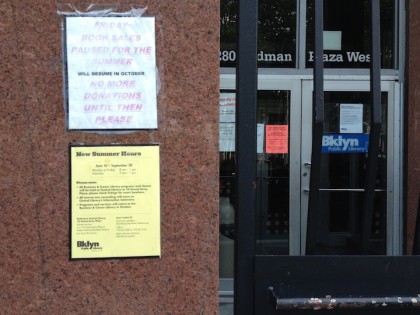With soaring summer temperatures imposing shortened hours of operation, the non-functioning air conditioning system of the Brooklyn Heights branch library on Cadman Plaza West stands as a flagrant example of the Brooklyn Public Library’s ongoing financial woes. And BPL’s projected solution for the problem—the sale and demolition of the two-story building in favor of a massive high-rise housing a new branch on its lower floors—seems to many a cure worse than the illness.
For the past few years, BPL’s administration has warned of the need for millions of dollars in emergency capital repairs, an amount that has now ballooned to $82,000,000, part of a larger capital deficit of some $308,000,000.
As chronicled in the first installment of BHB’s three-part series examining the Library’s capital funding issues, these problems did not arise overnight. Like the New York and Queens Public Library systems, BPL’s financial troubles are long-standing, as the Library struggles to maintain an aging network of 60 branches while accommodating greatly expanded usage.
Said Julie Sandorf, President of the Charles H. Revson Foundation, dedicated to enhancing the quality of the city’s three library systems, in a September 2013 presentation to the City Council about their capital construction needs, “Over the past decade, our city’s libraries have seen a 27 percent increase in program offerings, a 40 percent increase in program attendance, and a 59 percent increase in circulation,”…. [B]ranches across the city are suffering from decades of neglect and underinvestment.” Ms. Sandorf noted that the average Brooklyn branch is more than 60 years old, including 18 Carnegie branches built more than 90 years ago.

